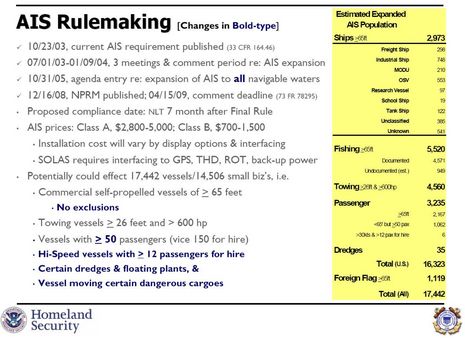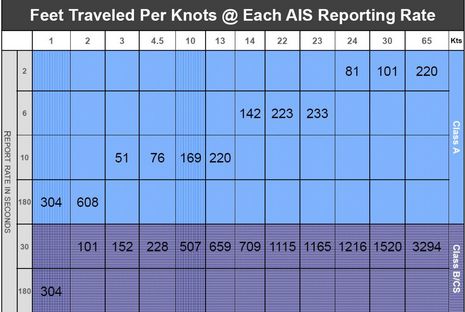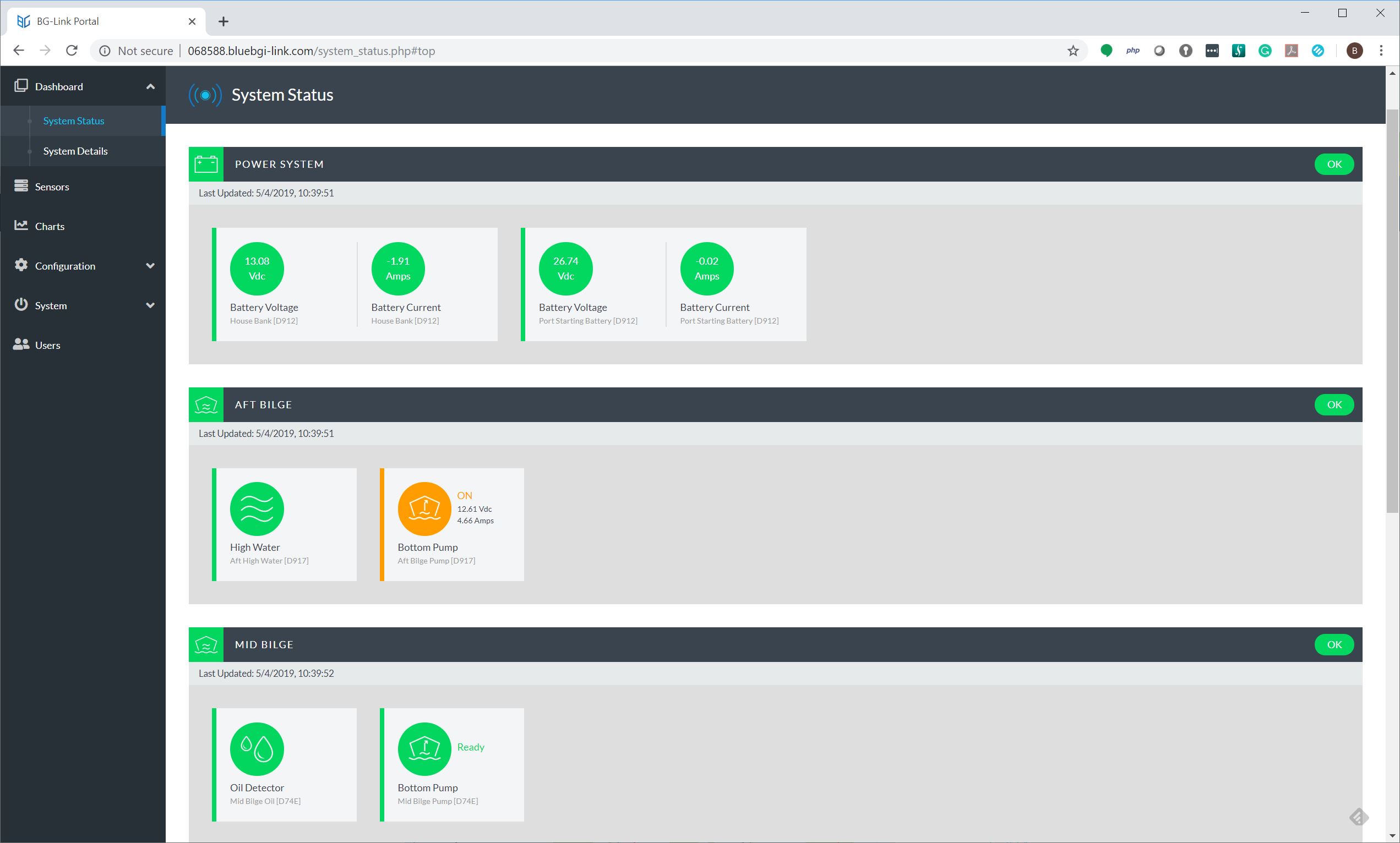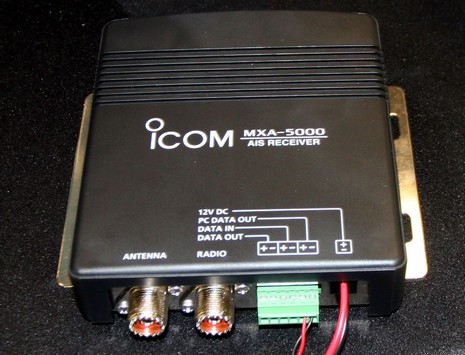USCG AIS mandates, get’er done, please!
I’ve been wondering what happened to the Coast Guard’s plan to require AIS on lots more commercial vessels plying U.S. waters, first discussed here in December ’08. Unfortunately the legalese around federal rulemaking means that the normally very informative Jorge Arroyo — project manager in the CG’s Office of Navigation Systems — can only say that the comments collected in early 2009 are being analyzed. I hope the Final Rule comes out soon, because looking at that slide above I see that compliance after the rule will take about half a year and, man-o-man, I’d like see those particular 17,442 vessels transmitting AIS ASAP…
For instance, among those 5,520 fishing vessels over 64′ are a bunch that have caused me a fair bit of night watch anxiety; when they’re at work out on the Gulf of Maine they’re usually burning wicked bright deck lights (that must obscure their vision) and going every which way, sometimes in widespread gangs. (AIS could also help protect those guys from greater dangers than yacht jockeys like me.) And among the 2,167 passenger vessels over 64′ are lots of Maine State Ferries that are often the biggest, scariest moving object encountered during a foggy day cruise. AIS on all those boats is going to be very good thing, and I’ll bet that many of you can visualize similar examples off that list. Which came, incidentally, from a presentation that Arroyo gave to various key groups, and which you can find in full here.
That’s also where I found the table below, which shows how many feet a vessel will move between AIS transmissions, depending on its speed and which type of AIS it’s carrying. I’ve been nattering about this situation for years, but these numbers cast it in a new way. A Class A vessel going 30 knots transmits every 2 seconds, or 100 feet, while a Class B is still transmitting at 30 seconds, which equals 1,500 feet, which equals a quarter mile, which equals close-in plotting that’s pretty darn “jumpy”. (And never mind the inexpensive “multiplexing” AIS receivers that flip flop from one channel to other, and thus will probably only see that fast Class B once per half mile; if you own one, consider an uprade.) As discussed in that original entry, and in Arroyo’s presentations, the USCG went into this rulemaking process unsure which commercial vessels would be allowed to carry Class B and which might be made to install Class A. I’m wondering if what seems like a long period of “comment analysis” (it may not be long in government terms) may be partially about waiting for less expensive Class A transponders to come to market. Like the ComNav Voyager X3, which hopefully is just the first of many. Whatever, I, for one, would like to see this deal get done.















I, for two, agree. I’ve read the minutes of those ‘town hall’ meetings, and am left with a bad taste from the energy invested in crying about an expenditure of less than $1000 per vessel. It’s easy to pick out the the bigger vessels, the ones to suffer the least from a collision: they complained the most!
On paper, it looks like most attendees opposed the NPRM. Perhaps we need to pad the ballot box to get a balanced result.
Well, it’s more like $3,000, plus antennas, plus installation, but still…
Ben, you know what would help? Some data on collisions that could likely have been avoided had one or more of the vessels involved had AIS onboard. Seen anything like that?
I think you’re both right. Vessels required to carry Class A transponders will have to spend about $3,000, assuming the cost of the compact 2nd generation transponders gets close to $2,000 as promised. Vessels allowed to fulfill the mandate with Class B transponders will have to spend about $1,000.
Cant see what the fuss is about.
Over here (UK) all vesssels over 300GRT is mandatory fit, as it is for all vessels carring 12 passengers or more proceeding to sea. All tugs that I have seen have a transponder installed as do most UK F/V’s.
Take a look at the english channel AIS here:
http://www.marinetraffic.com/ais/default
Busiest sealane in the world.
You will see what I mean, and it’s been this way for four or five years now.
Steve.
As of July 2009 all the Cross Sound Ferry vessels that run between New London, Connecticut and Orient Point, Long Island were not required by law to have AIS transponders. Here are the vessels:
https://www.longislandferry.com/Default.asp
If you notice, the capacity on the biggest vessel runs to 1000 passengers and 120 cars. I asked the first mate on one of the ferries why they don’t transmit AIS and his answer was,
“We’re not putting it on until the Coast Guard tells us we have to”.
I believe the ferry companies are fighting to shield themselves from legal liability in the event of a navigation incident. They have no interest in safety, or the threat to other vessels sharing the waterways beyond what it might cost them. When an electronic technology like Class A, AIS is readily available at such a low cost it is unforgivable for a big company like the Cross Sound Ferry not to immediately and voluntarily implement this device whether the law requires it of not.
For a recreational sailor like me with a twenty two year old boat, purchasing and installing Class B AIS is a huge chunk of my cruising budget, but I did it for safety reasons. The Cross Sound Ferry can cover the cost of a Class A installation in one trip across the Sound and has arrogantly refused the technology.
The “AIS Rule Making Change” needs language that opens up liability for any and all of the ferry companies that refuse to use AIS. Cost is not a consideration here as it may be for a family run lobster boat.
The sooner the better!
When you get out of the US you really see the difference. With all the commercials and most good-sized yachts carrying AIS, finding a safe course is a snap (relatively speaking, of course).
The draggers on Georges Bank are really a problem. Can’t see their running lights because of deck lights, and as you say Ben, they go in all directions. And you never know if someone will continue towing or stop and haul back. If they all had AIS it would be much easier.
Sorry, Lets try that link again…
http://www.marinetraffic.com/ais
Steve
Richard,
I suspect that as these ferries are inter-island, their get-out clause under SOLAS is that they are not “proceeding to sea” but that doesnt happen in Greece FI which has a huge number of ferries plying around their Islands, they all have AIS under SOLAS.
So does SOLAS/GMDSS regs apply in US as in most of the rest of the civilzed world or not??
Steve.
This is very exciting, but I guess I’m going to have to figure out how to get my receiver to stop beeping when there’s an AIS equipped vessel a quarter of a mile away…
Steve, SOLAS rules are global, but only apply to vessels voyaging international. Many nations have added further mandates, including the U.S. The added U.S. rules are summarized at the bottom of the top slide, with the proposed changes bold faced.
For instance, a lot of fishing and passenger vessels over 65′ got exempted from the mandates the first time around, but won’t be this time.
Ben, that’s good and shouldnt come soon enough for you guys. You can understand our confusion when most of this has been in place here for well over five years. Our MCA&CG are merciless, as are the French and most of Euroland in applying the rules.
Obviously these changes will need to be enacted into US law as they are here into Euro/National law.
I suppose the timing depends on how long the die hards can string it out with appeals ‘n stuff.
Steve.
I think you might be underestimating the costs for the larger inspected commercial vessels — you can’t just drill a hole in some fiberglass and drop a cable down for the antenna. Pretty much everything has to be approved by a naval archichtect and approved by a whole host of inspectors(not least the insurance inspectors) to ensure that you haven’t messed up the integrity of the vessel’s design.
I was at a shipyard recently and was shocked by how much some rather simple changes to our state ferries were going to cost, but the yard manager explained what they actually had to do and it made sense — somewhat. (Of course the words “state” add a lot of cost but that is another story.)
Still, I think that this needs to be done — the benefits far outweigh the costs. I can understand the initial reluctance, though.
I wish that the towing exemption was for “less than 24′ AND less than 600 HP”. Towboats are one of the biggest threats around here (think “narrow tidal rapid” and “300 logs”) so I really think that all towboats should have AIS. To their credit, most seem to.
If AIS is an actual requirement that may get enforcement against boats not using it – don’t a lot of them need a dual installation or onboard spares to cover for the inevitable hardware failures in a harsh environment? If its optional, and the AIS breaks, you have an opportunity to buy a new one and install when it arrives, with a downtime of a few days.
A lot of yachties are worried about their chartplotters beeping continuously because of boats on “collision courses” in crowded harbors. Seems as though the plotter manufacturers need to upgrade.
Fugawi shows me these targets in red, but I can configure the beeping. At sea I want to know about any target with a CPA of less than 2 miles, but in NY harbor that would be useless information.
AIS should be made mandatory for all engine driven commercial craft above a open boat in my opinion
Plagiarized from an industry professional, but worth a look:
For every KT of speed, a vessel will travel 6076 Feet.
So a vessel doing 10 kts will cover 60760 feet in an hour. (In one minute, a vessel will travel 1011 feet, and every second, the vessel will travel 16.86)
With a report rate of 30 seconds, (class B) this vessel doing 10kts send out a position report about every 510 feet.
On a typical AIS capable radar operating on the 1.5NM range (RTCM Category one 180mm 7� display)
On this 7 inch display, one inch of screen is = .214 NM, or 1300 ft. So there is 4550 ft of effective screen ahead of the vessel.
So 4550 divided by 510 ft per report (at 10 kts) means that the operator will see 9 pos reports from a class B heading right at him, if he�s standing still.
If both vessels were doing 10 kts, the operator would see 4 reports (maybe)
If both vessels were doing 15 kts, the operator would see At this closing speed, operator�s will see 3 (maybe) position reports. Meanwhile, the radar will have painted the target and updated (at 24 RPM) every 2.5 seconds. So the radar will have updated the target more than 12 times, as opposed to the AIS update of only 30 seconds.
Over 30 seconds, 1500ft will be covered with 2 vessels each doing 15 kts, closing speed of 30kts.
A good analogy to use would be to imagine a radar antenna operating at 2 RPM. Completely and utterly useless.
IMHO, Class B is ok for harbor / port security uses. But should only be considered for use as a Navaid on vessels operating under 5kts (oil rigs, dredges, stationary vessels / drill rigs) but not OK for navigation / collision avoidance, nor is it OK for input to a radar unless filters are able to ignore class B completely are installed.
No question, class A is better for bigger vessels and others traveling fast.
On the other hand, the first of those reports (given decent software on the receiving vessel) would tip the watchstander off that there was something out there heading his way, and would give him a CPA and keep updating the position by DR.
This is LOTS better than nothing, which is what we often have now.
At sea, in any kind of seaway, radar is helpful, but a small boat slews around so much it is hard to get a consistent bearing on a target at any distance more than a few miles, so there is a real need for something else.
“… not OK for navigation / collision avoidance, nor is it OK for input to a radar unless filters are able to ignore class B completely are installed.”
Hey, “anonymous”, why don’t you set your “typical AIS capable radar” at 3/4 mile range on a 5-inch display? It would make your argument work better, and it would only be slightly more ridiculous.
Also, how come your “industry professional” entirely left out AIS CPA/TCPA alarms? Even if there was a good reason that some watch stander was doing 15 knots in limited visibility with his or her radar only seeing 4,550 feet ahead on a small screen, a Class B vessel in a meeting situation could set off an alarm at least five miles away, depending on how the alarms were set up. Irregardless of what radar range was set.
Incidentally, if that watch stander turned off AIS CPA alarms and got in a collision, I believe he or she would find themselves in a pant load of trouble. To my knowledge this hasn’t come to court yet, but a lot of experienced mariners — pros included — think AIS will be regarded like radar. If you have it, you’re obliged to use it properly.
The same goes, big time, for the concept of “ignoring Class B completely”; it’s not only not going to happen, but it looks like the IMO and others are going to oblige many commercial vessels to integrate AIS, both kinds, into radar and ECS/ECDIS. In fact, check out the USCG ruling referenced above; they clearly want vessel operators to use AIS better.
I do wish that Class B AIS dynamic data was transmitted faster than 30 seconds, but I’m confidant that we’ll learn to deal with it like it is, despite a few really negative souls like yourself. Then again, I’ve actually experienced how useful it can be at sea when encountering commercial traffic. Funny, none of them seemed to have their displays set at 1.5nm range.
Recall that unlike radar, every “paint”(*) of an AIS target gives you speed and direction. You can get a target’s estimated vector from radar, but it requires multiple paints and operator intervention (on any radar people like us could afford). AIS is more accurate and automatic, therefore the refresh rate is not really equivalent to radar. Faster is beter, but it is not a radar antenna operating at 2 RPM!
The system breaks down for high speed vessels that make a lot of course changes (like the Canadian SAR hovercraft that scared the pants off of me) but radar is no good in those situations either. That is why I am a little wary of it for pleasure craft; AIS-equipped jet skis would just be an annoyance and clutter. I’m most concerned with large fast moving vessels, and they typically do not make a lot of course changes.
I’m not quite sure I understand the issue with the fishing vessels; for me their nets are a greater concern than their direction. I just give them a wide berth if I can, talk to them on VHF if I can’t. They won’t care if I transmit AIS because with lines and nets in the water there is not much that they can do to avoid me. Is there a special AIS category for fishing vessel towing a net? That would be nice — assuming that the fishers turned it on when appropriate.
(*) I know how AIS works but I’m trying to keep with the radar analogy.
“On a typical AIS capable radar operating on the 1.5NM range…On this 7 inch display, one inch of screen is = .214 NM, or 1300 ft. So there is 4550 ft of effective screen ahead of the vessel.”
Come to think of it, Anonymous and his purported “industry professional” screwed up their already stilted radar presumption, though they over complicated the analysis enough that it’s hard to notice. Radar range is a radius, not a diameter. A radar set a 1.5nm sees 1.5nm in all directions. 1.5nm = 9,100 feet. (And if the radar screen is rectangular or the set is in offset mode, the operator would be seeing even further ahead.)
So we have someone lecturing us condescendingly about AIS who doesn’t know much about radar! Where do these people come from? Why would anyone develop a nearly irrational dislike for AIS?
There are some other advantages of adding AIS to your boat as I have found to date with an ACR class B unit connected to RayMarine E120. The AIS acts as a backup GPS data source as all the lat/lon and other GPS info is also being send to the plotter. Using standard PL-259 connectors the AIS antenna, which I am using a standard 8′ VHF unit is a backup antenna for your radio and with an adapter can be used with your portable VHF. To date I have collected data from a class A at 14+ nm range even with considerable land in between, at 15 kts that is one full hour of visibility.
Its possible that most of the objections posted during the public forums on the Coast Guard’s NPRM follow the strategy posted at http://regulatoryseas.wordpress.com/2009/04/06/pva-urges-members-to-comment-on-recent-aisnoad-ruling/
I note that this article expresses no concern whatsoever about the threat these companies represent to smaller vessels!
Ben,
I think it (the nearly irrational dislike for AIS) might be in part a response to poorly-engineered chartplotter software. I have had some correspondence with a gentleman who was very concerned about adoption of AIS by recreational vessels becasue of the many alarms he would have to deal with, and because he liked the convenience of “any vessel with AIS is someone you need to keep clear of.”
A new AIS story:
We just ran from Cape May to Block Island, and out on the edge of the bottom near Hudson Canyon we ran into a large group of draggers as well as the usual New York traffic. At one point there were 10 targets on the radar (at 6 mile range) and 12 AIS targets in addition. Only 2 of the radar targets had AIS, so it became a guessing game as the draggers towed, stopped to haul back, and turned around to tow again. The 2 with AIS were really easy to deal with, by comparison.
4,232 days in the making! A lot more commercial vessels in U.S. waters will soon have Class A or Class B AIS:
https://www.federalregister.gov/articles/2015/01/30/2015-01331/notices-of-arrival-and-departure-and-automatic-identification-system-vessel-requirements
1) Did I read this right, they expect the savings to include 3 lives over 10 years, and 106 barrels of oil not lost.
Are things that safe on the water or does AIS have that little impact in commercial maritime, that AIS can only save 3 lives?
2) I found it interesting that this ruling has an effect of discontinuing certain restrictions on AIS AtoN, that might be the reason they are few of them … quote “Existing AtoN regulations (see 33 CFR 66.01-1 Basic Provisions) bar the use of AIS as a Private Aid to Navigation, and thus preclude the use of an AIS AtoN on certain fixed structures.” … skip text … “These amendments to parts 62 and 66, which allow for enhanced MDA and improved navigation safety, would not require anyone subject to our rule to establish an AIS AtoN, they would merely make that option available.”
Hi Dan, I can’t find any reference to 3 lives over 10 years in the Final Rule. Do you recall where you read it?
Did you read it right and/or did they write it right?
ummm…no. After Table 7 (page 42 of the PDF), Section VIII.A, there is a bit of analysis of past accidents and thought as to how the new rule would have helped. It is worded a bit strangely. Here is part of it (there’s much much more):
The major reason behind this rule is security from terrorism of ports, cruise ships, etc, but we will never know how many lives will be saved from attacks that never happen. Table 8 considers the possibilities of 12, 150, and 2000.
hint to find this: search for ‘casualties’
My turn to ask if I have read it right. Section VI.B.8, “AIS Displays and Integration” (p.33 of PDF).
In other words, certain boats are required to have AIS and some of those are allowed to use Class B. Those must transmit AIS but they are not required to watch the AIS display (if any).
Ben & Norse, it looks like 3 lives over 14 years, by dividing the $ savings ($25.1 to 31.2 million from 1996 to 2010) by $9.1 million per life, from the text below in executive summary.
We estimate the total discounted benefit (injuries and fatalities avoided) for the AIS portion of the final rule, derived from marine casualty cases for the period 1996 to 2010, to be between $25.1 and $31.2 million, using $9.1 million for the value of statistical life (VSL) at 7- and 3-percent discount rates, respectively. We expect the AIS portion of this final rule to prevent on average 14 barrels of oil (undiscounted) from being spilled annually, or between 85 and 106 barrels at 7- and 3-percent discount rates, respectively, over the 10-year period of analysis.
You’re right. In the section I mentioned above they say avoided injuries and fatalities is about $3.6 million per year, and since they used a “VSL” of $9.1 million, that works out to about 4 lives per 10 years. Close enough, no point quibbling about a fantasy number. My comment before was that this cost-benefit number does not include the risk of a terrorist attack, which they do consider. I didn’t realize that that portion of the analysis did not make it into the executive summary. It is reasonable to extrapolate past collision data for a cost analysis, although it should be mentioned how poor such an estimate actually is. It is not reasonable to extrapolate past terrorist attack data, given changing conditions. The way I read this document is that the major consideration was maritime security.
I could go on about how poor this cost-benefit analysis is, but I will stop with the comment that it does not measure the benefits of AIS of avoided near misses.
Agreed, poor cost-benefit, and if I read it correctly its only in the commercial sector they are estimating … not recreational.
The question is, are things that safe on the water or does AIS have that little impact in commercial maritime, that AIS can only save 3-4 lives in ten years?
Agreed that the cost-benefit analysis is not comprehensive or important. I think it’s just a difficult exercise they have to go through.
But, Norse, I am curious how you decided that the new rules are more about maritime security than safety? It seems to me that there is tremendous overlap of those functions when it comes to AIS. The users are safer and the watchers have more to see. How do you determine motive?
At any rate, could we please continue this discussion on the new entry about the Final Rule:
https://panbo.com/archives/2015/02/more_ais_in_the_usa_the_new_uscg_requirements.html